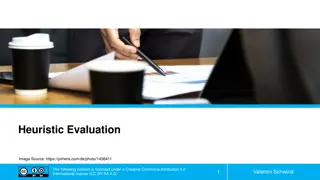
Heuristic Evaluation and Interface Consistency in HCI Learning
Explore the principles of heuristic evaluation and interface consistency in HCI, focusing on components like consistency, error recovery, and error prevention. Learn the importance of predictability and different types of consistency within interfaces. Discover how to help users recognize, diagnose, and recover from errors effectively.
Download Presentation

Please find below an Image/Link to download the presentation.
The content on the website is provided AS IS for your information and personal use only. It may not be sold, licensed, or shared on other websites without obtaining consent from the author. If you encounter any issues during the download, it is possible that the publisher has removed the file from their server.
You are allowed to download the files provided on this website for personal or commercial use, subject to the condition that they are used lawfully. All files are the property of their respective owners.
The content on the website is provided AS IS for your information and personal use only. It may not be sold, licensed, or shared on other websites without obtaining consent from the author.
E N D
Presentation Transcript
Heuristic Evaluation 2 CPSC 481: HCI I Fall 2014 Anthony Tang with acknowledgements to Saul Greenberg and Ehud Sharlin 1
Learning Objectives By the end of the class, you should be able to: Understand and be able to describe components of three heuristics: consistency & standards; error recovery; error prevention Distinguish and describe three different types of interface consistency 2
4 Consistency and Standards Principle of least surprise similar things should act similarly different things should look different Adhere to platform guidelines Consistent language, colour, wording, ordering Consistent use of input syntax 3
Types of Consistency internal consistency is the interface consistent with itself external consistency is the design consistent with similar types of applications/applications on the platform metaphorical consistency is the design consistent with the similar real-world entity/object 5
4 Consistency and Standards Principle of least surprise similar things should act similarly different things should look different Adhere to platform guidelines Consistent language, colour, wording, ordering Consistent use of input syntax 6
5 Help users recognize, diagnose, and recover from errors Use plain language Identify the problem Constructively suggest a solution 8
How so? So which is it? Still sucks, but I know what to do now. 9
Error messages are too far away from where they can be corrected. Also, can we say nerd language for the error messages themselves? 12
ABORTED Be polite don t blame FATAL 13
Be polite even when youre coding for yourself 14
Provide suggestions/examples Restate the user s input not cannot open file , but cannot open file named paper.doc 15
5 Help users recognize, diagnose, and recover from errors Use plain language Identify the problem Constructively suggest a solution 16
Cart return lane Constraining width of the lane makes it impossible to get it wrong 23
6 Error Prevention Design to prevent errors from occurring Eliminate error- prone conditions Present users with a confirmation option before they commit to the action 24
Prevention techniques (on the small) Grey out illegal commands Avoid typing errors through selection 25
More Error Prevention (on the small) Provides auto-complete suggestions for city Date picker for dates (while still allowing for text-entry) Greys out inappropriate check out dates given check in dates 26
Error Types Slips (and lapses) failure to correctly execute a procedure slip is a failure of execution; lapse is a failure of memory typically found in skilled behaviour Mistakes using wrong procedure for goal typically found in rule-based behaviour or problem-solving behaviour 27
Slips (and lapses) Capture error frequently done activity takes charge instead of intended one leave your house, and end up walking toward school instead of to the grocery store Description error intended action similar to others that are possible pour orange juice on cereal throwing shirt into toilet instead of hamper 28
Slips (and lapses) Loss of intention forgetting the goal partway walking into a room, forgetting why you went there Omissions due to interruption get coat out, interrupted by phone call; then go out without coat Omissions due to already satisfied goal walking away from ATM w/o card walking away from copier without originals 29
Slips (and lapses) Mode errors people do actions in one mode thinking they are in another refer to a file that s in a different directory vi looking for commands / menu options that are not relevant 30
Preventing Capture and Description Slips Avoiding habitual action sequences with identical prefixes Avoid actions with very similar descriptions Keep dangerous commands away from common ones 31
Preventing Mode Errors Eliminate modes Increase visibility of mode Spring-loaded or temporary modes Disjoint action sets in different modes 33
Avoiding Lapses Keep procedures short Minimize interruptions Use forcing functions automatic transmission: you must hold down brake to shift out of Park must take card out of ATM before you get your money 34
6 Error Prevention Design to prevent errors from occurring Eliminate error-prone conditions Present users with a confirmation option before they commit to the action 36
Learning Objectives You should now be able to: Understand and be able to describe components of three heuristics: consistency & standards; error recovery; error prevention Distinguish and describe three different types of interface consistency 37






















